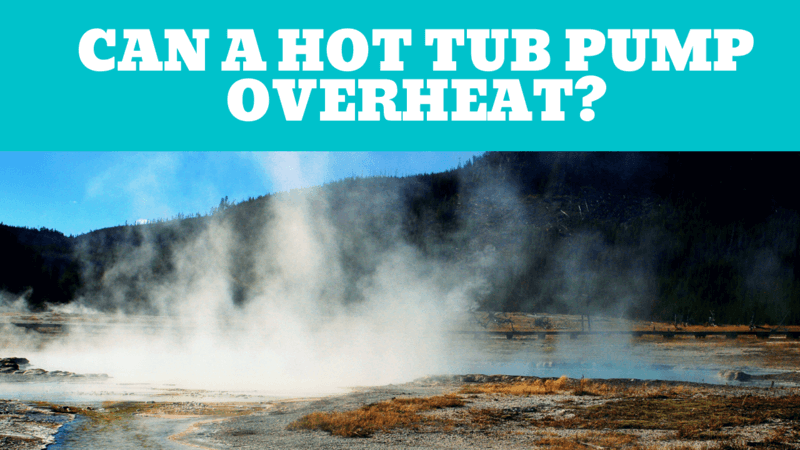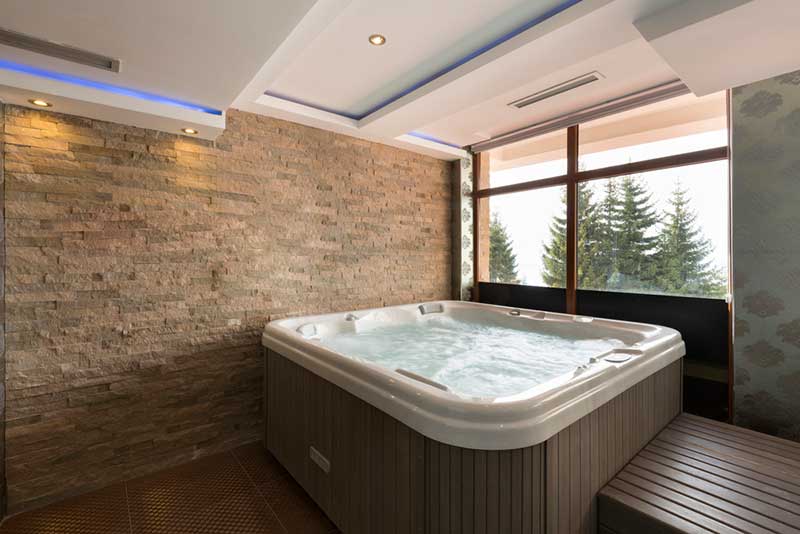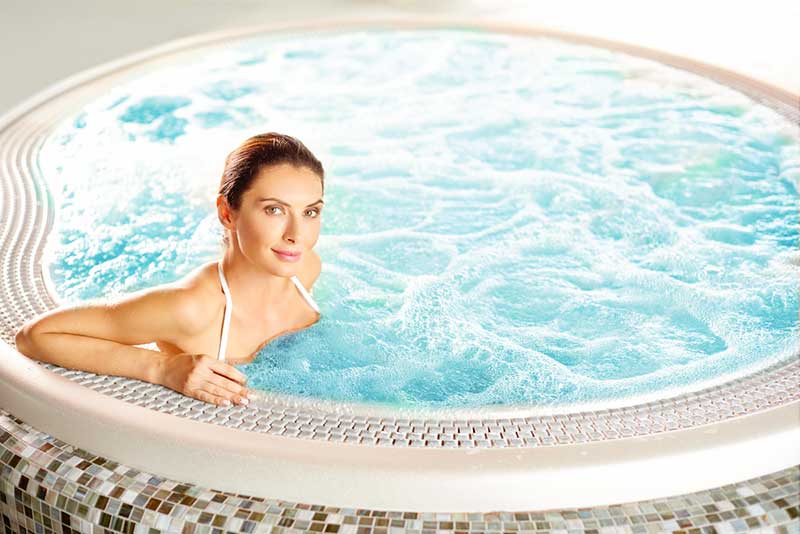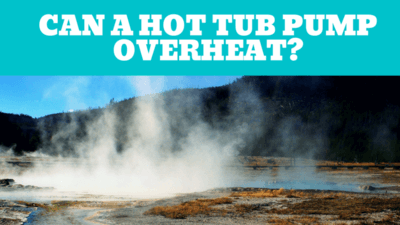
If you have noticed your hot tub water is extra hot it might be that your hot tub pump is overheating. There are a number of reasons why this might be happening and I decided to check it out to find out more about whether hot tub pumps could overheat and, if they could, what could be done about it.
So, can a hot tub pump overheat? A hot tub pump can overheat if there is a problem or blockage within the valves, circuitry or pipes. This could result in the pump becoming overloaded and over-exerting itself causing overheating. However, there are other reasons why the water in your hot tub could be hotter than you expected.
If you’ve found that the temperature of your hot tub water has crept up, it could be down to environmental factors. If the weather is very warm, thermal creep is more likely to be the cause of your excess heat than an overheating pump. Another possibility is that the thermostat has been set too high, or perhaps the filter cycle has been set to run too frequently. It’s important to check out all of these possibilities before assuming that the problem lies with the pump.
Thermal Creep – The Most Common Cause Of Overheating Hot Tubs
All efficient spa tubs have been designed to keep as much heat inside them as possible so the cost of running them can be kept low. While this is a clever design, when the weather is very warm it’s possible that the hot tub could end up going several degrees above the temperature that it has been set to. This doesn’t mean that there’s an issue with the hot tub – rather, it’s a phenomenon known as “Thermal Creep”.
Thermal Creep occurs when the hot tub’s temperature continues to go up since there is no way of allowing heat to escape. One primary cause of spa tubs going over their desired temperature is the electric motor that pumps water around the spa tub for powering the jets, and filtering and heating the water. Whenever the electric motor is running, heat is generated, and that heat will then be transferred into the water inside the hot tub. This causes the water temperature to exceed the temperature that the thermostat has been set at.
During the summer months, this is a particular problem, since it’s possible for hot tubs to reach as high as 30 degrees Celsius simply from the heat generated by the motor even before the heater is switched on! When the weather outside is very hot, it makes sense that the water inside the tub will quickly reach a temperature that is much higher than you’d expect under normal circumstances.

Even when the weather is very hot, you shouldn’t just switch off your hot tub pump to keep the heat down. It’s still necessary to have the hot tub pump switched on since the water has to be filtered and circulated around the system to prevent problems from occurring. Hot tubs need to be filtered for about 2 – 4 hours each day and, therefore, during this time, the water absorbs the heat emitted from the pumps and there is very little that you can do about this.
Add to that the problem of overheating due to the location of the hot tub. If it is located in an area that is especially exposed to the sun’s rays, it’s even harder to dissipate heat from the spa. Often, spa owners choose a sunny spot in which to site their hot tub because they want to be able to relax in the water on a warm day.
However, this can backfire during especially hot months. When the weather outside is extremely hot, a spot in your garden that was perfect on cooler days can suddenly make it unbearable to use your spa. This is something you may want to consider when choosing the right spot for your hot tub if you’re selecting a permanently installed model rather than one which is inflatable or portable.
How Can I Reduce The Heat In A Hot Tub?
If you’ve discovered that your hot tub is too warm because of environmental conditions, you’ll need to think of a way of reducing the heat in the hot tub if you’re to continue enjoying your spa without any discomfort.
Luckily, there are a few solutions that you can consider. In fact, some spa manufacturers have already considered the eventuality of their products overheating and have included some features in their designs to overcome the issue.
Some modern hot tubs are able to cope with the overheating problem by shutting the filtration system down until the temperature is lower, while others reduce the amount of time spent filtering the water. Some spas also feature vents which can be closed or opened to suit the season and to allow any excess heat to leave the water.
If your hot tub doesn’t automatically shut down the filtration system when it’s overheating, it is possible to reduce the filtering duration of your tub to keep it from exceeding your desired temperature manually. However, you mustn’t forget to return the settings to normal once the weather is cooler. Alternatively, you can adjust the time that filtration is carried out so it occurs at a cooler time of the day.
Check the water level of your tub too. If the level is too low it could cause the pump to overheat. If you find that the water level has dropped too low due to evaporation you can easily top it up using your garden hose. This should reduce the temperature while also resolving the problem.

Other solutions include opening the jets’ air controls to draw warm air in from the interior of the hot tub so it can dissipate more rapidly. If you choose this option, though, you’ll need to check the Total Alkalinity levels of the water more frequently. You can also keep the cover of your hot tub propped open, remove any perimeter insulation around the tub, or open an access panel on the tub’s side to allow the excess heat to dissipate.
If your hot tub is a portable type, you may consider moving it to a different part of your garden or outdoor space so that it can benefit from more shade. This will help to keep the water at a more comfortable temperature.
You can also set your thermostat to a lower temperature, or drain some water out of the tub and replace it with fresh water which will reduce the temperature temporarily.
I’ve Tried These Solutions And My Spa Is Still Overheating!
If you’ve tried all of the above solutions and found that your hot tub is still overheating, the problem could be the pump after all. Some hot tub pumps have a tendency to run hot, but when they overexert themselves it causes a host of issues.
There are several causes for a hot tub pump overexerting itself. One common cause is an obstruction inside the plumbing lines. Sometimes, items become stuck inside the impeller and this results in excess strain on the pump’s motor. It’s therefore important to check to make sure no debris is inside the lines.
You should also check the suction grates for any damage or cracks. If you find any, replace them to ensure no additional debris can access the pump lines. While you’re checking the components of your spa, check the service valves too. If they’re not fully open, this could result in an overexerted pump.
Before you blame your hot tub pump for the overheating problem, you need to ensure that it’s receiving the correct voltage. Bad relays are also a circuit board problem that can cause overheating. Should you suspect that this is the issue you’ll need to contact a hot tub engineer since rectifying this type of issue is a specialist job that requires professional assistance.
Should the problem lie with the spa pump motor you’ll need to decide whether a replacement of the entire pump is necessary or whether a new motor would suffice. In many cases, replacing the whole pump is the best option, but if yours is just a few years old, replacing just the motor could be the right solution for you.
Again, contacting a professional hot tub engineer is the best option if you need to replace either an entire pump or the motor since working with water and electricity together is very dangerous and requires professional training.

I Think My Hot Tub Pump Is Overheating – What Should I Look Out For?
If your hot tub pump is overheating, its motor life can be greatly reduced and damage can occur to the piping that surrounds the motor. Even relatively new pumps can become too hot then stop working, thus requiring replacement, so it’s important to know the signs to look out for that indicate your pump isn’t functioning properly.
- You won’t be able to touch the pump. If you’re able to touch the spa pump (note, not the motor) and it’s temperature is relatively comfortable, the pump is likely to be functioning properly. On the other hand, if it’s hot when you touch it (make sure that you take great care when trying this, though), or any steam is visible, your pump is definitely running too hot.
- The pump is noisy. If the pump makes a sound similar to rocks tumbling about inside it, it could be cavitating. This occurs when the suction lift becomes too high and there is either a partial blockage of the suction line or the water temperature is too high. It’s important to take action quickly if you hear this sound from your pump since cavitation causes major damage to the pump’s impeller.
- The pump is losing prime. The pump’s internal components depend on liquid running past them in order to stay cool. When a pump loses prime, the water in the pump cases gets very hot because of friction from the impeller. Eventually, it will turn into steam. Should this occur, the high temperatures generated damage the seals, impeller and plastic piping that is connected to the spa pump. The main reason for pumps losing prime is air leaks in the suction line or leaking shaft seals.
- Clogs. If there is a blockage in the strainer or suction line, the water flow can be restricted and result in either loss of prime or cavitation. Both cause pumps to overheat.
- Excess current is being drawn by the motor. Water pumps have a maximum amount of current that should be drawn when the motor is under a full load. If this occurs, it indicates there is an issue with the pump or the motor. There are a number of reasons why the pump may draw excess current. These include band windings in the pump motor, wiring to an incorrect voltage, or bad bearings.
If you spot any of these signs, it’s important to get professional advice from a hot tub electrician or engineer. An overheating pump is a serious issue that could cause further damage to your hot tub so you need to get the issue rectified as quickly as possible to avoid costly repairs.
How To Troubleshoot A Spa Pump
A hot tub pump should last between five and ten years, although some will last longer or shorter periods of time. Nevertheless, at some point, it’s likely that every spa pump will experience an issue of one type or another. Troubleshooting your pump is important if you’re to determine whether you need a brand new one or whether a repair will be sufficient to restore the function of your tub.
- No pump action – if the pump isn’t working at all you may see an error code on the control panel. Make sure your power source is switched on and that the GFCI test button or breaker haven’t been tripped. Make sure all the valves have been opened, then check the plumbing to see if the hose has any kinks or bends in it. Take the filter out too as this will allow you to see if the flow improves.
- The pump is noisy – usually, hot tub pumps operate quietly, so if yours is noisy that means there’s a problem. This could be a clogged impeller, scale, excess air in the system, or even a dirty filter. It could even be the motor bearings going bad. You can check for excess air by loosening the union nut so air is released and forcing air from the lines using your garden hose. You can remove any scale deposits by using chemicals or a stiff brush, and remove clogs from the impeller by opening the pump and checking for debris. If the bearings in the motor are the cause of the problem you can test them by disconnecting the plumbing then switching it on briefly to check for noises. If noises still occur, the bearings need to be replaced. Alternatively, the motor or the entire pump may need replacing.
- Poor function – a spa pump won’t wear out and start pumping less water as it gets older. It will either function or it won’t. If the water volume being pumped is too low, you need to first remove the hot tub filter to check if the water flow improves. If the problem still exists after you’ve cleaned the filter, the filter should be replaced.
Related Questions
At what temperature should my hot tub thermostat be set during the summer months? There’s no single answer to this question since, at the end of the day, it’s all down to your own personal choice. However, many users prefer to lower the temperature of their hot tub when the weather is hot so that bathing is more comfortable. Many people select a temperature between 32 and 37 degrees Celsius during the summer months so that they can enjoy a warm, bubbly soak without feeling too warm.
Can I leave the lid off my hot tub completely to allow the heat to dissipate more quickly? Although you can prop the lid of your hot tub up a little by using a small brick or block of wood, it isn’t a good idea to leave the lid off the tub completely for any length of time when you aren’t using it.
This is because debris can easily get into the water and this can not only make it unpleasant to bathe but it can also cause blockages in the pipes and filtration system that could make the pump overheat or cause another issue with the function of the tub. Make sure that you replace the lid of your hot tub whenever you aren’t using it to keep the water clean and to reduce running costs in the long run.

